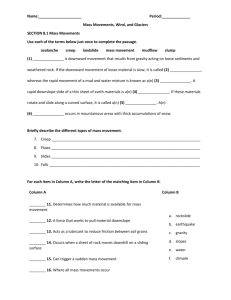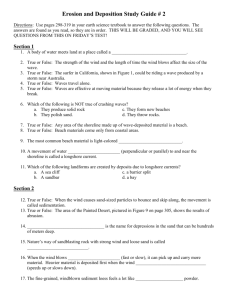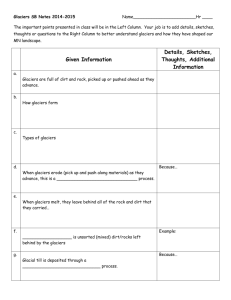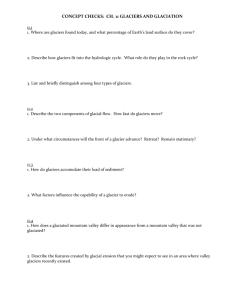Chp 8 Study Guide_Mass Movements
advertisement
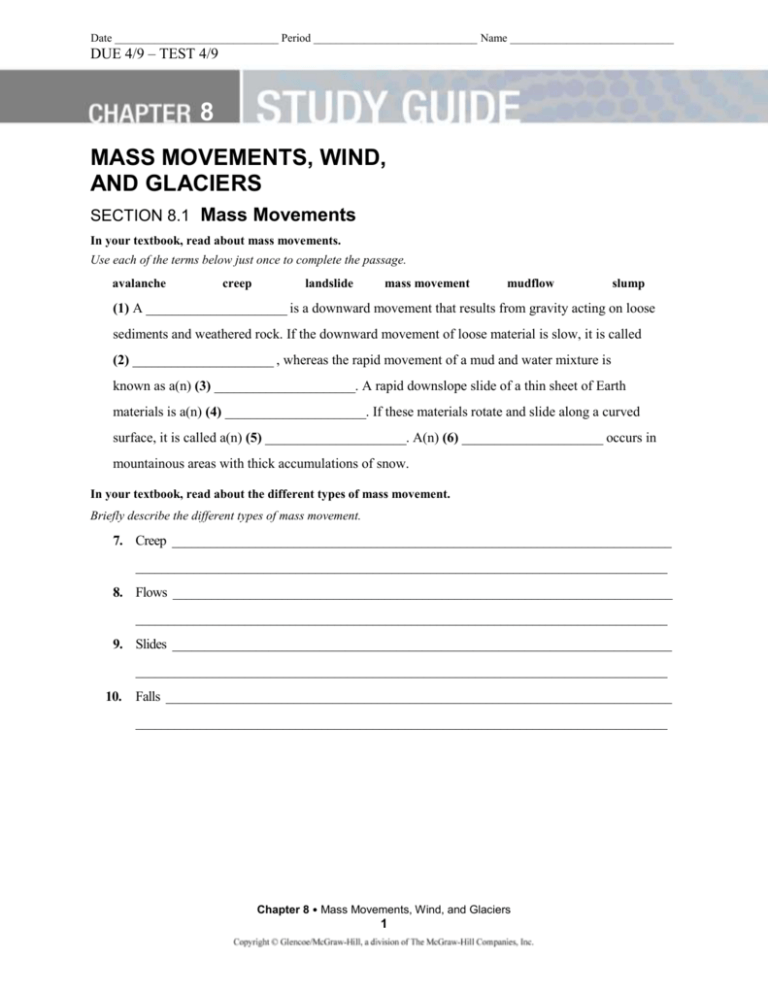
Date _____________________________ Period _____________________________ Name _____________________________ DUE 4/9 – TEST 4/9 8 MASS MOVEMENTS, WIND, AND GLACIERS SECTION 8.1 Mass Movements In your textbook, read about mass movements. Use each of the terms below just once to complete the passage. avalanche creep landslide mass movement mudflow slump (1) A ______________________ is a downward movement that results from gravity acting on loose sediments and weathered rock. If the downward movement of loose material is slow, it is called (2) ______________________ , whereas the rapid movement of a mud and water mixture is known as a(n) (3) ______________________. A rapid downslope slide of a thin sheet of Earth materials is a(n) (4) ______________________. If these materials rotate and slide along a curved surface, it is called a(n) (5) ______________________. A(n) (6) ______________________ occurs in mountainous areas with thick accumulations of snow. In your textbook, read about the different types of mass movement. Briefly describe the different types of mass movement. 7. Creep ______________________________________________________________________________ ___________________________________________________________________________________ 8. Flows ______________________________________________________________________________ ___________________________________________________________________________________ 9. Slides ______________________________________________________________________________ ___________________________________________________________________________________ 10. Falls _______________________________________________________________________________ ___________________________________________________________________________________ Chapter 8 Mass Movements, Wind, and Glaciers 1 Name ____________________________ 8 continued SECTION 8.1 Mass Movements, continued In your textbook, read about mass movements and the factors that control them. For each item in Column A, write the letter of the matching item in Column B. Column A Column B ______ 11. Determines how much material is available for a mass movement a. rockslide ______ 12. A force that works to pull material downslope b. earthquake ______ 13. Acts as a lubricant to reduce friction between soil grains c. gravity ______ 14. Occurs when a sheet of rock moves downhill on a sliding surface d. slopes ______ 15. Can trigger a sudden mass movement e. water ______ 16. Where all mass movements occur f. climate In your textbook, read about people and mass movement. Answer the following questions. 17. How do mass movements affect people? ____________________________________________________________________________________ ____________________________________________________________________________________ ____________________________________________________________________________________ 18. How do people contribute to mass movements? ____________________________________________________________________________________ ____________________________________________________________________________________ ____________________________________________________________________________________ Chapter 8 Mass Movements, Wind, and Glaciers 2 Name ____________________________ 8 continued SECTION 8.2 Wind In your textbook, read about wind erosion and deposition. Use each of the terms below just once to complete the passage. abrasion deflation dunes loess ventifacts The lowering of the land surface caused by the wind’s removal of surface particles is called (1) ______________________. The process of erosion in which wind causes particles such as sand to rub against rocks is (2) ______________________ . Rocks shaped by this process are called (3) ______________________ . Over time, wind-blown sand accumulates to produce (4) ______________________ . If the wind carries and drops finer particles such as silt, deposits known as (5) ______________________ form. For each statement below, write true or false. _________________________ 6. In suspension, strong winds cause particles to stay airborne for long distances. _________________________ 7. During the 1930s in the Great Plains, poor agricultural practices resulted in severe dust storms and the formation of deflation blowouts. _________________________ 8. Most sand carried by the wind moves by saltation. _________________________ 9. The steeper slope of a sand dune is on the windward side, the side protected by the wind. _________________________ 10. Wind erosion tends to occur in areas of heavy vegetation cover. _________________________ 11. Dune migration is caused by prevailing winds continuing to move sand from the windward side of a dune to the leeward side. Chapter 8 Mass Movements, Wind, and Glaciers 3 8 Name ____________________________ 8 continued SECTION 8.2 Wind, continued In your textbook, read about the types of sand dunes. Complete the table by filling in the missing information. Diagram Type of Dune A 12. B 13. C 14. D 15. How and Where Formed In your textbook, read about wind erosion and deposition. Circle the letter of the choice that best answers the question. 19. Which of the following results in the formation of desert pavement? a. abrasion b. deflation c. deposition d. saltation 20. Which of the following is true of loess? a. It consists of sand and gravel. Earth. c. Its soils are some of the most fertile on b. It is deposited by melting ice. d. Its most common component is gypsum. Chapter 8 Mass Movements, Wind, and Glaciers 4 Name ____________________________ 8 continued SECTION 8.3 Glaciers In your textbook, read about glaciers. Use each of the terms below just once to complete the passage. cirques moraines continental glacier outwash plain drumlins valley glacier eskers glacier A large mass of moving ice is a(n) (1) ______________________. A moving mass of ice formed in a mountainous area is a(n) (2) ______________________ , and one that covers a large continent-sized area is a(n) (3) ______________________. Deep depressions called (4) ______________________ are carved by mountain glaciers. When glaciers melt, they deposit (5) ______________________ , which are ridges consisting of till. A melting glacier also forms a(n) (6) ______________________ composed of sorted gravel, sand, and fine silt. Glaciers that move over older moraines form (7) ______________________ , which are elongated landforms. Sometimes glacier meltwater deposits long, winding piles of sediment called (8) ______________________. In your textbook, read about glacial erosion and deposition. Complete the table by filling in the missing information. Glacial Feature Description 9. Groove 10. Moraine 11. area at the leading edge of glacier where meltwater deposits outwash. Chapter 8 Mass Movements, Wind, and Glaciers 5 Name ____________________________ 8 continued SECTION 8.3 Glaciers, continued In your textbook, read about glacial erosion. Label the diagram below. Choose from the following: cirque, arête, horn, hanging valley, U-shaped valley. In your textbook, read about glaciers. Circle the letter of the choice that best completes the statement or answers the question. 1. Outwash is deposited by a. glacial ice. c. glacial meltwater. b. high winds. d. gravity. 2. Continental glaciers form from a. sorted sediments deposited by meltwaters. b. snow that accumulates and recrystallizes. c. valley glaciers that flow downslope and meet. d. mixed debris dropped by ice. 3. Which of the following is true of striations? a. They are formed by plucking. b. They are formed by deposition. c. They occur only on glacial outwash plains. d. They indicate a glacier’s direction of movement. 4. Sometimes ice breaks off a glacier, gets covered by sediment, and later melts. When the resulting depression fills with water, it forms a. a kettle lake. c. a moraine-dammed lake. b. an esker lake. d. a cirque lake. Chapter 8 Mass Movements, Wind, and Glaciers 6
